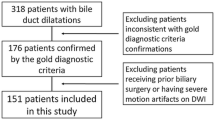Abstract
The authors compared computed tomography (CT) and endoscopic retrograde cholangiopancreatography (ERCP), techniques commonly used to study the biliary tree, with pre- and post-Gd-DTPA breath-hold fast low angle shot (FLASH) and fat suppressed spin-echo in 28 consecutive patients with bile duct abnormalities detected on ERCP, including 11 patients with malignant disease and 17 patients with benign disease. ERCP, CT, and magnetic resonance (MR) images were prospectively interpreted in a blinded fashion and reviewed by consensus. ERCP characterized all cases of malignant disease by the presence of a narrowed bile duct lumen with irregular margins. CT and MRI detected all cases of malignant disease and characterized nine of 11 as malignant. In seven of these cases, CT and MRI showed thickening of extrahepatic bile duct walls >5 mm. MRI images showed intrahepatic-enhancing periportal tissue in four cases, which was not seen on CT images, and which was biopsyproven tumor extension. Benign disease was characterized on ERCP images by the demonstration of smooth tapered narrowings in 16 cases, whereas on CT and MR images it was characterized by mild to moderate dilatation of the intrahepatic bile ducts and wall thickness < 5 mm in 13 cases. Overall ERCP correctly characterized 27 cases as benign or malignant and CT and MRI both characterized 25. The results of this study show a trend that ERCP is superior to CT and MRI for characterizing bile duct disease.
Similar content being viewed by others
References
Teefey SA, Baron RL, Rohrmann CA, Shuman WP, Freeny PC. Sclerosing cholangitis: CT findings.Radiology 1988;169:635–639
Schulte SJ, Baron RL, Teffey SA, Rohrmann CA Jr, Freeny PC, Shuman WP, Foster MA. CT of the extrahepatic bile ducts: wall thickness and contrast enhancement in normal and abnormal ducts.AJR 1990;154:79–85
Dooms GC, Kerlan RK Jr, Hricak H, Wall SD, Margulis AR. Cholangiocarcinoma: imaging by MR.Radiology 1986;159:89–94
Sagoh T, Itoh K, Togashi K et al. Gallbladder carcinoma: evaluation with MR imaging.Radiology 1990;174:131–136
Matsui O, Kadoya M, Takashima T, Kamayam T, Yoshikawa J, Tamura S. Intrahepatic periportal abnormal intensity on MR images: an indication of various hepatobiliary diseases.Radiology 1989;171:335–338
Sze G, Soletsky S, Bronen R, Kiol G. MR imaging of the cranial meninges with emphasis on contrast enhancement and meningeal carcinomas.AJR 1989;153:1039–1049
Edelman RR, Siegel JB, Singer A, Dupuis K, Longmaid HE. Dynamic MR imaging of the liver with Gd-DTPA: initial clinical results.AJR 1989;153:1213–1219
Hamm B, Fischer E, Taupitz M. Differentiation of hepatic hemangiomas from metastases by dynamic contrast-enhanced MR imaging.J Comput Tomogr 1990;14:205–216
Semelka RG, Chew W, Hricak H, Tomei E, Higgins CB. Fat saturation MR imaging of the upper abdomen.AJR 1990;155:1111–1116
Semelka RC, Hricak H, Stevens SK, Finegold R, Tomei E, Carroll PR. Combined gadolinium-enhanced and fat-saturation MR imaging of renal masses.Radiology 1991;178:803–809
Mitchell DG, Vinitski S, Saponaro S, Tasciyan T, Burk DL Jr, Rifkin MD. Liver and pancreas: improved spin-echo T1 contrast by shorter echo time and fat suppression at 1.5 T.Radiology 1991;178:67–71
Baron RL, Stanley RJ, Lee JKT et al. A prospective comparison of the evaluation of biliary obstruction using computed tomography and ultrasonography.Radiology 1982;145:91–98
Baron RL, Stanley RJ, Lee JKT, Koehler RE, Levitt RG. Computed tomographic features of biliary obstruction.AJR 1983;140:1173–1178
Adson MA, Farrell MB. Hepatobiliary cancer: surgical considerations.Mayo Clin Proc 1981;56:686–699
Ham JM, Mackenzie DC. Primary carcinoma of the extrahepatic bile ducts.Surg Gynecol Obstet 1964;118:977–983
Author information
Authors and Affiliations
Rights and permissions
About this article
Cite this article
Semelka, R.C., Shoenut, J.P., Kroeker, M.A. et al. Bile duct disease: Prospective comparison of ERCP, CT, and fat suppression MRI. Gastrointest Radiol 17, 347–352 (1992). https://doi.org/10.1007/BF01888585
Received:
Accepted:
Issue Date:
DOI: https://doi.org/10.1007/BF01888585




